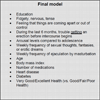Risk factors for incident erectile dysfunction among community-dwelling men
- PMID: 19929915
- PMCID: PMC3538839
- DOI: 10.1111/j.1743-6109.2009.01600.x
Risk factors for incident erectile dysfunction among community-dwelling men
Abstract
Introduction: Compared to the prevalence of erectile dysfunction (ED), fewer studies have focused on the incidence of ED and even fewer have focused on nonmedical risk factors.
Aim: We examined psychosocial, demographic/socioeconomic, medical/behavioral, and sexual function risk factors at T1 (1987-1989) and development of incident ED at T2 (1995-1997).
Methods: Longitudinal population-based epidemiologic study of 814 community-dwelling men participating in the Massachusetts Male Aging Study.
Main outcome measure: ED was defined according to a validated, discriminant-analytic formula based on questionnaire responses and categorized as moderate/complete ED vs. none/minimal. Multivariate logistic regression models (odds ratios [ORs] and 95% confidence intervals [CI]) were used to estimate the association of risk factors with ED.
Results: Among 814 men free of ED at T1, 22% developed moderate/complete ED at T2 (on average, approximately 8.8 years later). In a multivariate model, sexual function variables captured at baseline were inversely associated with ED (e.g., more or similar level of sexual arousal compared to adolescence vs. less, OR = 0.56, 95% CI: 0.34, 0.92; frequency of sexual thoughts at least two to three times weekly vs. less, OR = 0.55, 95% CI: 0.33, 0.92) after adjustment for age, education, and other risk factors.
Conclusions: Our results indicate that in the context of other risk factors, sexual desire variables at baseline were associated with incident ED. This in turn suggests that indications of reduced function appear earlier than ED itself, and that there may be a time window for intervention before a loss of erectile function.
Conflict of interest statement
Figures
Similar articles
-
Sexual activity, erectile dysfunction, and incident cardiovascular events.Am J Cardiol. 2010 Jan 15;105(2):192-7. doi: 10.1016/j.amjcard.2009.08.671. Am J Cardiol. 2010. PMID: 20102917 Free PMC article.
-
Metabolic syndrome in men with low testosterone levels: relationship with cardiovascular risk factors and comorbidities and with erectile dysfunction.J Sex Med. 2013 Oct;10(10):2529-38. doi: 10.1111/jsm.12265. Epub 2013 Jul 30. J Sex Med. 2013. PMID: 23898860
-
Male Sexual Function in New Zealand: A Population-Based Cross-Sectional Survey of the Prevalence of Erectile Dysfunction in Men Aged 40-70 Years.J Sex Med. 2017 Jul;14(7):928-936. doi: 10.1016/j.jsxm.2017.05.011. J Sex Med. 2017. PMID: 28673435
-
Relationship Between Cannabis Use and Erectile Dysfunction: A Systematic Review and Meta-Analysis.Am J Mens Health. 2019 Nov-Dec;13(6):1557988319892464. doi: 10.1177/1557988319892464. Am J Mens Health. 2019. PMID: 31795801 Free PMC article.
-
Talking about sex: erectile dysfunction in the oncology patient.Endocr Relat Cancer. 2023 May 11;30(6):e220401. doi: 10.1530/ERC-22-0401. Print 2023 Jun 1. Endocr Relat Cancer. 2023. PMID: 36971778 Review.
Cited by
-
Low-intensity extracorporeal shockwave therapy for erectile dysfunction: an overview of systematic reviews.Transl Androl Urol. 2021 Sep;10(9):3684-3696. doi: 10.21037/tau-21-730. Transl Androl Urol. 2021. PMID: 34733663 Free PMC article.
-
Aging and sex hormones in males.Virulence. 2017 Jul 4;8(5):545-570. doi: 10.1080/21505594.2016.1259053. Epub 2016 Nov 10. Virulence. 2017. PMID: 27831823 Free PMC article. Review.
References
-
- U.S. Food and Drug Administration. Orange Book: Approved Drug Products with Therapeutic Equivalence Evaluations. FDA; 2009.
-
- Gazzaruso C, Solerte SB, Pujia A, Coppola A, Vezzoli M, Salvucci F, Valenti C, Giustina A, Garzaniti A. Erectile dysfunction as a predictor of cardiovascular events and death in diabetic patients with angiographically proven asymptomatic coronary artery disease: a potential protective role for statins and 5-phosphodiesterase inhibitors. J Am Coll Cardiol. 2008;51:2040–2044. - PubMed
-
- Thompson IM, Tangen CM, Goodman PJ, Probstfield JL, Moinpour CM, Coltman CA. Erectile dysfunction and subsequent cardiovascular disease. Jama. 2005;294:2996–3002. - PubMed
-
- Schouten BW, Bohnen AM, Bosch JL, Bernsen RM, Deckers JW, Dohle GR, Thomas S. Erectile dysfunction prospectively associated with cardiovascular disease in the Dutch general population: results from the Krimpen Study. Int J Impot Res. 2008;20:92–99. - PubMed



